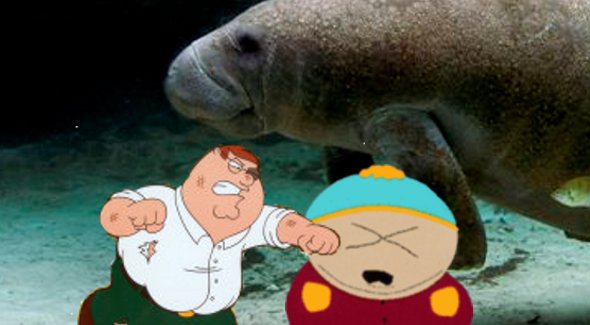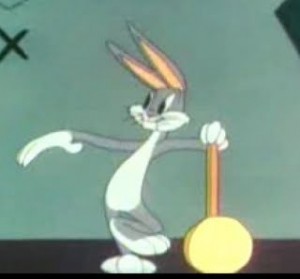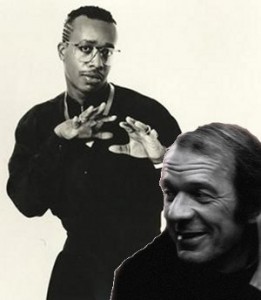South Park and Family Guy don’t get along. In 2006, the two-part South Park episode “Cartoon Wars” characterized the writers of Family Guy as an a tank full of manatees randomly manipulating beach balls to generate the show’s scripts. Cartman (who is often depicted as a comedy writer) voices his (and according to the commentary track, the show’s) complaint thus:
“I am nothing like Family Guy! When I make jokes they are inherent to a story! Deep situational and emotional jokes based on what is relevant and has a point, not just one random interchangable joke after another!” —Eric Cartman, “Cartoon Wars I,” South Park
Family Guy made no immediate response, but this season produced the episode “Spies Reminiscent of Us,” which featured a dig at South Park‘s argument.
Peter gets the only laughs (big, loud, suspiciously artificial laughs) of the improv show when he injects out-of-context, pre-written gags. Even though the audience loves Peter, Quagmire sees the show as a failure. During their group’s rehearsal, Quagmire repeats many of the mantras of traditional improv comedy, including “don’t think” and “keep it going.” Quagmire seems to be a stand-in for a particular philosophy toward comedy outlined by Del Close and Charna Halpern in their improvisational comedy work. The philosophy promotes exactly the kind of organic, narrative, character-based comedy described by Cartman in the top quote. In Family Guy, Quagmire’s adherence to this philosophy at the expense of entertainment put him at odds with Peter (and, therefore, Seth MacFarlane) and, because Peter got laughs and Quagmire did not, in the wrong.
If the conflict between the two shows is a conflict between two comic ideologies, we at least understand the theatre-geek mentality that produces South Park. What, then, is the theory inside Family Guy, and why does it clash with what Cartman describes as “emotional” comedy?
South Park‘s major problem with Family Guy is the insert gag. In “Cartoon Wars,” the fictional episode of Family Guy seems to be a string of (uncharitably flat) cutaway jokes that do not relate to the narrative action. For South Park, these gags are not funny because they are “random,” not because the joke isn’t funny. The “randomness” interrupts the diegetic reality of the central emotional narrative of the episode by diverting the plot (momentarily) into a parallel universe without a causal or physical relationship with the narrative universe. Since the jokes can never change the circumstances of the central narrative, they are without emotional weight. The audience is not permitted to relate to these gags as anything other than cleverness. It is the narrative equivalent of a stand-up monologue, rather than improv theatre.
Aristotle’s Poetics lists the tools used to create emotional connections with the action of a narrative: unity of time, unity of action and unity of place. By firmly establishing a boundary around the story (it occurs over this time period, contains these events and happens here), the narrative gives a window into a universe in which the audience’s reality does not exist. In this way, the audience can temporarily abandon their identities in favor of the unity of the story. This allows for an emotional purging (catharsis) at the end of the action. When these unities are disrupted by anything that undermines the “rules” of the story’s universe, the catharsis is diluted.
Family Guy employs certain tricks from Aristotle’s bag, including the three-act structure, a plot that arises from character flaws, etc. Where Family Guy diverges is in its relationship to hammerspace. Hammerspace, in cartoon comedy, is the unrepresentable, infinite space that a character might reach into to retrieve a hammer (or anything else). Family Guy uses time the way Bugs Bunny or Harpo Marx use hammerspace, reaching into the hammer-timespace continuum to pull out a gag. The gag that occurs in hammertime is as separate from the temporal causality of the show’s narrative universe as the hypothetical hammer is from Bugs Bunny’s spatial universe, which is to say, both separate and not separate. Gilles Deleuze describes this world without boundaries, without dialectics, as a “plane of immanence.” All of the unities that Aristotle declared essential to creating a subject-object relationship between the audience and the events of the story are suddenly mutable and non-unified.
“Immanence is not related to Some Thing as a unity superior to all things or to a Subject as an act that brings about a synthesis of things: it is only when immanence is no longer immanece to anything other than itself that we can speak of a plane of immanence.” —Gilles Deleuze, Pure Immanence

Stewie's having a hard time coming up with a Gilles Deleuze joke.
When Peter or another Family Guy character says, “This is worse than the time…” and brings us into hammertime and hammerspace for a gag, we are not traveling into the plane of immanence. Rather, the plane of immanence is all of Family Guy, and all of the comedy universe that is connected to the hammer-timespace continuum. Our consciousness cannot experience the universe causally, as there is no causality (though there is also enough causality for plot). Our senses are useless, because the universe has no concrete set of rules that generates the sensations we would use to experience it (though we can see and hear the universe as it is presented to us). At any moment, any rule at all may be broken, including the rules that tell us who we are specifically supposed to be. As Deleuze puts it, “the life” becomes “a life,” loose in a boundless existence.
The post-structuralism of Family Guy is offensive to the structuralist, modernist, constantly-proselytizing children of South Park. While Family Guy is perfectly capable of including South Park in its world view, South Park, a show that comes from a specific theatrical tradition tied strongly to Aristotle, rejects the anti-dialectic of the immanent world. This one-sided argument is why Family Guy couldn’t retaliate with their own criticism of South Park, apart from a broad swipe at Quagmire’s theatrical demagogy. Family Guy can’t really have a point of view, since it undermines subjecthood, so it can’t really attack another point of view. The best it can do is defend itself by arguing that, if it’s funny, it’s probably all right. Seth MacFarlane said as much at Harvard University in June, 2006:
“…cutaways and flashbacks have nothing to do with the story. They’re just there to be ‘funny’. That is a shallow indulgence that South Park is quite above, and, for that, I salute them.” —Seth MacFarlane




Thanks to my friend Eleanor for help with this. She’s super smart.
I think that part of the anger directed at the Family Guy style is related to its seeming laziness. it’s very hard to create a universe that is internally consistent and filled with characters that have real, well-developed personalities. Even harder still is telling funny jokes using that universe. It is certainly possible that Seth MacFarlane made a conscious choice to reject traditional storytelling and create this universe without rules. It is equally possible, however, that he simply doesn’t care about, or is incapable of, putting forth the effort to create a more cohesive narrative. Art doesn’t need to be complex to be rewarding, but it is often difficult to separate the intentionally minimal from the simply incompetent.
“Family Guy uses time the way Bugs Bunny or Harpo Marx use Hammerspace, reaching into the Hammer-timespace continuum to pull out a gag. The gag that occurs in Hammertime is as separate from the temporal causality of the show’s narrative universe as the hypothetical hammer is from Bugs Bunny’s spatial universe, which is to say, both separate and not separate. “
I had faith in your argument until you threw Harpo under the Hammerspace bus.
Bugs Bunny’s mallet is never separate from his Bunnyverse (likewise for any cartoon prop, no matter how ridiculous or out of place): we’re not talking about Schrodinger’s cat, which we conceptualize to exist in a world wherein life and death are considered mutually exclusive. That cat might exist in the Hammerspace you describe, until the box is opened and the parameters of its existence must be described in order for it to fit into the universe in our heads.
However, in the Bunnyverse, there are few to no concrete laws that would prevent a mallet from appearing out of midair. The appearance of objects is as acceptable as resurrection, the immediate restoration of health, etc. Duck Amok shows us that not even the depicted universe (backgrounds, bodies) are constant. If Hammerspace exists as a universal-law-exempt deux-et-machina, then what place would it have in a universe with no laws to begin with (except maybe character sheets, but has anyone seen Mickey Mouse lately?) in which the characters are their own machina?
To need to assert Hammerspace in Bugs’ cartoon universe is to misunderstand the laws of that universe. The answer to “where did the mallet come from?” is not “Hammerspace,” it’s “behind that tree.”
If I follow your later argument correctly, wherein the universe becomes the plane of Immanence: it follows that Bugs himself exists in this plane, that his Bunnyverse (and perhaps any cartooniverse) is Hammerspace (Adventures of Roger Rabbit).
There are laws in the Family Guy universe upon which the writers rely in order to create plot points and conflict that engages the audience beyond the unrelated gags. Hammerspace in this instance exists both within the universe (so that the general framework of the world and the characters can be referenced to sell the gag) and outside the universe (so when the gag is over, we appear back where we were, nothing has really changed and the writers are freed from consequences and explanation).
I wasn’t sure, reading your article, if you were implying that Family Guy (the entire show) exists within the Plane of Immanence or if the POI encompasses only gag sequences. If you believe that the entire show exists within the POI, then how can we empathize with Stewie losing his teddy bear (“Road to Rupert”), or being disappointed by Mother Mary (“Road to Europe”)? Why bother with these plots, and why would viewers watch them? You might argue that Brian entering a downhill skiing competition falls into POI territory, but since the premise of the show is that Brian is more human than dog, I would argue otherwise. Likewise with Stewie’s death ray machines.
If you believe that only the gag sequences exist in the POI, I agree with you and will send you a strawberry-frosted donut in the mail. But, that would negate your argument that Family Guy has nothing to say to South Park. Instead, it grounds the show in the structuralist world of South Park: instead of a tank of manatees, think of a vaudeville MC.
Anyway, none of this really upset me until I read “Harpo Marx.” Right next to Bugs Bunny and “separate from the temporal causality of the show’s narrative universe.” I’m going to argue this strongly: Harpo is the least POI-y character in a Marx Brothers film. Everything that Harpo does has more lasting influence on the emotional storyline of the film than the actions of his brothers (or even Margaret Dumont). In fact, Harpo often is the emotional storyline of the film, and will cause other characters to abandon the false “main” storyline to participate in his. A perfect example is the scene from Horse Feathers (1932) in which Groucho and Chico attempt to sign Chico’s college papers and call out for a “seal.” Harpo rushes off screen and comes back with a seal (bark bark, not stamp stamp), which nobody objects to and everybody chases off screen. Later in the film, Chico brings his new professor an apple, while Harpo brings a watermelon. Minutes into the lecture, Chico asks, “When you gonna cut the watermelon open?”
Perhaps most indicative that the ‘real’ universe belongs to Harpo: in the same classroom scene, Groucho scolds Harpo for putting up pictures over his scientific chart. He says, wearing an establishment costume and taking the role of the professor, “…you’ll learn that you can’t burn the candle at both ends.” To which Harpo reaches inside his coat to pull out a candle, burning at both ends. Groucho says, “Well, I was wrong.”
Yet, in what seems to be a contradiction, there is an actual appearing mallet in this film. In the scene where Maravelli and the Dog Catcher (Chico and Harpo) try to capture two football players, Harpo creates an escape by pulling a mallet out of nowhere and hitting one of the players over the head. Clearly the mallet comes out of nowhere, which would be a great argument that it came from Hammerspace.
So why don’t I think that Harpo is simply a character with constant access to the POI? Because, since Harpo is the driving narrative force (essentially, Harpo defines the universe), and you posit that Hammertime is separate from the temporal narrative (and I posit that Hammertime is necessary only when universe-specific laws must be broken), there is (just like with Bugs) no need for a separate POI to explain his actions. Harpo’s mallet is no strain on the Harpoverse– it simply is, in the same way he doesn’t speak, wears tear-away clothes and honks a horn and nobody thinks that’s even slightly odd.
Unlike with Bugs, there are still definite laws of the Harpoverse, which is why I wouldn’t say that the Harpoverse exists in the POI like Bugs Bunny & friends. For example, there is nothing that could occur in the Bunnyverse that would require a break in Bunnyverse logic or a schism in existing Bunnyversal rules. However, if we saw Groucho getting his head sawn off onscreen, complete with blood and x’s in his eyes, it would take some law-breaking to get him resurrected in the Harpoverse. Because there are laws that could be broken in the Harpoverse, the Harpoverse cannot exist in the POI as you describe it.
Conclusion: don’t diminish the emotional power of Harpo’s mallet by comparing it to Bugs Bunny’s mallet. These are two very different mallets, and two very different universes. Harpo’s appeal (to me) comes from the fact that his magic is not otherworldly but real, and that he exists in the world as you see him, kind of like Superman.
Also, I’m dope on the floor and I’m magic on the mic.
If the point of drama is to provide catharsis by taking us out of our reality, couldn’t the point of the asides be to provide meta-catharsis by taking us out of the current level of unreality?
Excellent article. (I have nothing of substance to add, nor points to debate.)
Oh, but curses for linking to tvtropes. There goes my weekend.
Quotation from TVTropes entry on Hammerspace:
“Harpo Marx can and does keep anything and everything in his (admittedly large) clothes, including a complete silver tea set, fully fueled welding equipment, live animals and burning matches. This only counts as Hammerspace from a viewer standpoint, however, because Harpo Marx actually did produce these items from his custom-made coat. It was a gag he developed for use live on stage.”
So even in the context of the fiction, where we’d be inclined to posit that he’s taking things from hammerspace, he legitimately was carrying the items on his person, though he’d have to have picked and chosen in advance which things he’d load the suit with.
@Lolo – You say, “If you believe that the entire show exists within the POI, then how can we empathize with Stewie losing his teddy bear (“Road to Rupert”), or being disappointed by Mother Mary (“Road to Europe”)? Why bother with these plots, and why would viewers watch them?”
Seems to me that’s only relevant if the plots described are actually compelling and artfully crafted – if the plots are the crux of the show, if they carry the weight of it. On Family Guy, the plots are secondary devices, existing only to create the illusion of cohesiveness needed to sell the show as half-hour scripted television. It is, like Seinfeld before it (although *shudder* less effectively,) stand-up masquerading as sit-com. The plot is merely window dressing for the gags. Which does not, of course, let them off the hook for interesting storytelling. It would be nice if the show had both.
And yet, one usually tends to see people counting The Simpsons as a great vehicle for both comedy and a cohesive story, since each individual episode is about one thing, and yet the majority of Simpsons episodes also begin with an act 1 that is only the most tenuously connected (if at all) to the rest of the “actual” plot of the episode, and was just an easy way to set the stage for that main plot with a laugh.
My issue with Family Guy was never the middle-of-the-story cutaways to imaginary flashback land, it was the fact that without the obvious disconnect of someone prefacing the random gag with “Remember when” or “It’s like that time” and everyone pausing to remember, you instead got irellevant gags that were right there in the middle of what’s going on. Kool-aid man bursting through the wall, ghost covered wagon being chased by Brian etc.
Everyone stopping what they were doing to remember a ridiculous past occurance isn’t nearly as disruptive to what little narrative Family Guy has, as the arbitrary sight gags in the middle of what’s going on.
@Dan:
And yet, one usually tends to see people counting The Simpsons as a great vehicle for both comedy and a cohesive story, since each individual episode is about one thing, and yet the majority of Simpsons episodes also begin with an act 1 that is only the most tenuously connected (if at all) to the rest of the “actual” plot of the episode, and was just an easy way to set the stage for that main plot with a laugh.
Well, you’re not completely wrong, but…
That barely-connected first act was one of the hallmarks of The Simpsons‘ “middle period,” between, say, season 9 and season 16 or so. I think of this as the weakest time in the show’s history, and most of the people I’ve spoken to about The Simpsons agree with me. The first six or seven seasons were completely devoid of this device, focusing almost exclusively on narrative, character-driven plots and humor rooted in the same. Rewatch a season 2 episode sometime, and you’ll see that it doesn’t at all match your description. (I recommend “Bart the Daredevil” or “Bart Gets an F.”)
Also, in recent years (not coincidentally, the same time Bill Odenkirk took over as show runner… I wanna say Season 17?), they’ve abandoned that device, and I believe the show is much the better for it. I think now we’re in kind of a “Silver Age” of The Simpsons; it’ll never be as good as it was those first few years, but I for one actually enjoy watching it again. The last couple of seasons have been filled with episodes that tend to start out on a topic, and mostly stick with it the whole way through. Take, for instance, the recent episode “The Great Wife Hope.” It starts by showing us the town’s new obsession with a sport that strongly resembles (but is legally distinct from) UFC, and ends… with Marge taking on the stadium’s owner in the ring. Very structurally tight. Still ridiculous, but structurally much tighter than those meandering, middle-period episodes.
I think perhaps you applied my point to a broader circumstance than I was actually intending it. Likely just poor phrasing on my part.
I didn’t meant to say “What family guy does is bad, but look, Simpsons which is accounted good does the same thing!” which is what it sounds like you took from my post.
What I meant to say was “A show like the Simpsons which is accounted good does this, why should doing this be justification for deciding that Family Guy is bad?”
A direct comparison between Family Guy and South Park when their fundamental guiding principles are not the same is just not especially pointful. They are both animated, and both comedies, but conflating them on those grounds works about as well as assuming that two non-animated comedies, say Seinfeld and Frasier, are the same. They have -many- similarities, but while Seinfeld was an endless series of one-offs with no real cohesive structure beyond a few recurring themes and the odd extended plotline, Frasier was substantially more story oriented and paid more attention to its past and future in each episode.
@Dan:
Really, I was just saying that I don’t consider the episodes of the Simpsons which utilize the unconnected-first-act trick good any more than you do.
But your points are duly noted as well.
:)
I once was talking to an NBC executive about sitcom writing, and she said that people in the industry have a term for what Family Guy does: “Using the plot as a clothesline to hang jokes on.” That seems about right. This isn’t necessarily a bad thing – I’d say to a large extent, the Marx Brothers don’t care about plot, except as a joke-delivery system. But I’m pretty sure the writers of Family Guy don’t give a damn about Chris or (especially) Meg, whereas the Simpsons writers adore everybody who lives in Springfield. Family Guy always makes me laugh, but it can sometimes feel a little soulless.
I really enjoy this thread, by the way. Good points all around.
It really is one of those things where people fall afoul of judging something by standards it never pretended to. If Family Guy made a big deal in its marketting about the exceptional plots and character development, then we could criticize them for failing utterly to live up to their claims, but Family Guy has never said that it’s talking about really important things (As per South Park) or developing a very internally consistant world (as per The Simpsons) it is, as Belinkie quoted, just a shell built to support jokes.
I’d much rather criticize them about the jokes that really aren’t very funny. Which is to say, “All the jokes that are based on being not funny, but being not funny for FIVE MINUTES STRAIGHT until you laugh just because they’re still doing it” and looking at you saying “Is it funny yet? *ten more seconds of vomit* Is it funny yet? *Ten more seconds of vomit*”
You know what Family Guy does that REALLY annoys me? When they simply recreate a scene from a movie or TV show. Not changing anything, not adding a punchline. Just recreating something. For instance, Stewie and Brian recreate the “stomping on the printer” scene from Office Space. That’s like a MINUTE of the 24-minute episode.
We get it Seth, you’ve seen Office Space. Gold star for you.
Which is interesting, considering he is also responsible for Robot Chicken which recreates scenes from movies or tv shows and changes them in a fundamental way to create comedic effect.
(Clearly by “he” I mean not Seth McFarland, but the fact that he has Seth Green on the show, and presumably contributing at least a little to what’s going on. Stupid too many people named Seth)